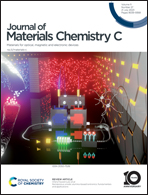Theoretical insight into the intrinsic electronic transport properties of graphene–biphenylene–graphene nanosheets and nanoribbons: a first-principles study†
Abstract
Recently, the successful synthesis of biphenylene network (BPN) monolayers (A. V. Matetskiy et al., Appl. Surf. Sci., 2021, 539, 148144) has resulted in significant progress in the study of carbon materials. Inspired by this material, the electronic structures and transport properties of graphene–BPN–graphene (G–BPN–G) nanojunction-based nanodevices are systematically studied using density functional theory and non-equilibrium Green's function methods. The results show that the I–V curves of two-dimensional (2D) and quasi-one-dimensional (Q1D) G–BPN–G devices exhibit intrinsic negative differential resistance (NDR) characteristics regardless of the electronic transport direction. But the electronic transport following the zigzag direction (Iz) is faster than that along the armchair direction (Ia) below a bias of 0.8 V, but when the bias is further increased, Ia is greater than Iz. For armchair-edged G–BPN–G nanoribbons, the metal or semi-conductive behaviors are dependent on their width and the kinds of passivated atoms on the edges. Specifically, the nanoribbons achieve the transition from semiconducting to metallic with an increase of the number of BPN in the heterogeneous structure by F-passivation and H-passivation. Moreover, O-passivated G–BPN–G nanoribbons always show metallic characteristics. Adjustable metal to semiconductor devices can be achieved by varying the combination of H- and O-passivated cells in Q1D G–BPN–G nanoribbon-based nanodevices. Overall, these interesting results demonstrate that these novel G–BPN–G devices have promising practical applications in future electronic nanodevices.



 Please wait while we load your content...
Please wait while we load your content...